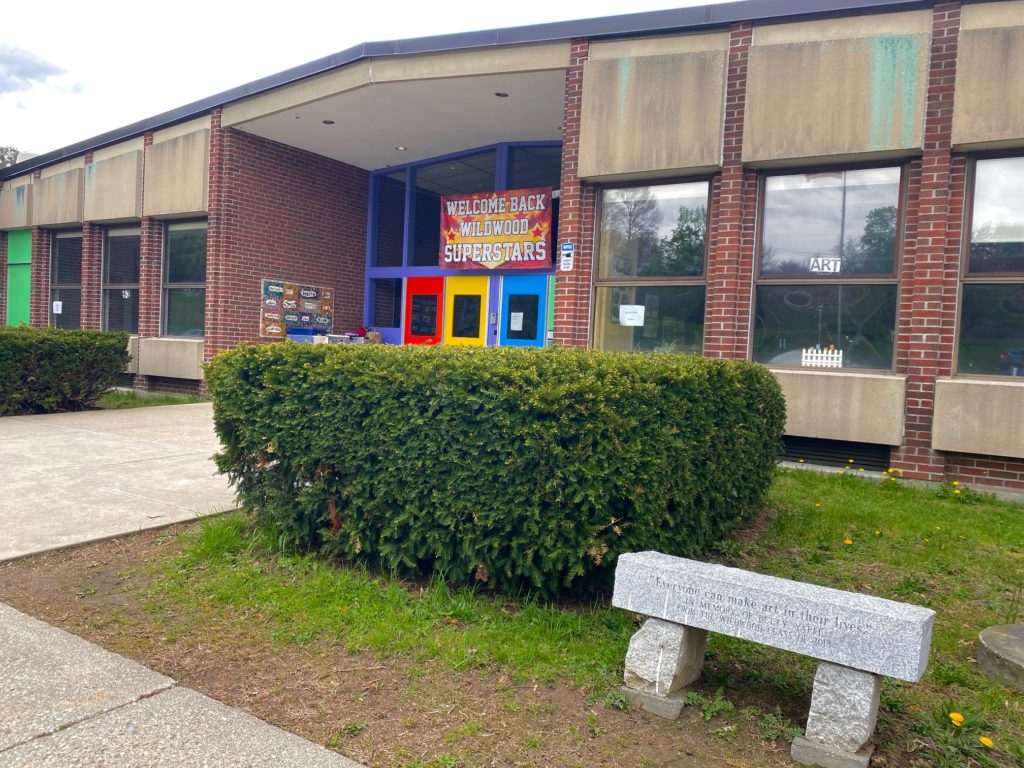Opinion: Jennifer Shiao’s School Committee Blog. Amherst’s School Building Project: We Need To Set Ourselves Up For Success

Wildwood Elementary School. Photo:Toni Cunningham
Editor’s note: The Indy will now post Jennifer Shiao’s School Committee Blog as new entries become available. Shiao’s original posts can be found here. An archive of her blog posts in The Indy can be found here.

February 12, 2022
At the February 8 Amherst School Committee meeting, the SC discussed a high-level summary of how space would be allocated in the new elementary school building. The summary was displayed in the form of a table on page 11 of the presentation given to the SC by Donna Dinisco, lead architect on the project. (To access the presentation, go to the February 8 meeting page, click on the agenda item “Building Project Update – Education Plan Presentation” then click on the attachment called “21555 22-02-08 School Committee (final).pdf)
First, a primer on how to read the table on p. 11, titled “Preliminary Design Program | Enrollment Alternatives.” The first two columns represent a building option that we are required to study (renovating or replacing Fort River only), and did not warrant any discussion by the SC. The second two columns are where we focused much of our time.
The column titled “Fort River + Wildwood Schools @ MSBA” had part of its title cut off due to formatting, and was actually called “Fort River + Wildwood Schools @ MSBA Standards (575 students)” in a previous version of this document. This column represents a high-level summary of the proposed space usage in the new school. The “MSBA Guidelines (575 Students)” column indicates the amount of space that the MSBA recommends based on their guidelines. (NFA stands for Net Floor Area; GSF stands for Gross Square Feet. You can think of both as “square feet of space.”)
The first eight rows are categories of space needed in the school. The Sub Total Program row is a sum of the eight rows above it. After you add up the proposed space for each category, you must then multiply by a “grossing factor” to account for hallways, bathrooms, stairs, and even just walls. (The MSBA uses a 1.43 grossing factor, but for this project our architects have used 1.5).
So, the total square feet for our proposed project is 113,765, which is around 29,000 more than what the MSBA would recommend for our project (85,052).
Phew! Are you with me so far?
So, for me, the important thing is not how big the school project is but how much will it cost Amherst taxpayers, and the size of the building is one of the main factors that determines the cost. The town manager and the town finance director gave a presentation to the Town Council in February 2021 on how the town would be able to afford four major building projects (elementary school, Jones Library, department of public works, and fire station). The model indicated an estimate of $80 million for the school building project, with the town’s share of that at $40 million (and the assumption being that the MSBA would fund $40 million ).
I asked Donna if she could give a rough, ballpark estimate of the cost of our building project, or even a rough cost per square foot. She said they weren’t ready to give a cost estimate or range at the time, and that she expected to be able to do that at the March 8 SC meeting, the meeting at which the SC is expected to vote to approve the educational program.
That said, using the figures that we do have, I did a rough back-of-the envelope calculation.
If we need the project to come in at $80 million (assuming MSBA will reimburse us for $40 million and the Amherst taxpayers will pay $40 million):
$80 million divided by 1.25 = $64 million. This 1.25 factor represents the “soft costs” that are not direct construction costs (“hard costs”), such as architect and OPM fees, site costs, etc. We don’t know what the soft cost amount will be, but a 1.25 factor (or 25% of construction costs) is a reasonable guess.
$64 million divided by 113,765 sq ft = $563 per sq ft
Is it reasonable to think that our building can be built for $563 per sq ft? Good question! I am not a construction expert, so I don’t claim to know the answer. Looking at data on recent MSBA projects tells me that there is a range from around $430 to $825 per sq ft. Given that our school building will be net-zero, per Amherst bylaws, do we think our building will end up being low, middle, or high of that range? These are all questions that need to be answered before the School Committee votes on March 8.
The cost of this project is important, because Amherst voters will be asked to approve a debt-exclusion override for it, a vote that is likely to take place in March 2023. Approving a debt-exclusion override means that voters are agreeing to “override” the state’s limit of 2.5% on how much towns can increase property taxes. In other words, the town can’t raise property taxes more than a 2.5% increase, to pay for this project, unless voters agree to it. (And the February 2021 presentation I referenced above stated that raising taxes via the debt-exclusion override is the only way the school project can be funded.)
The last time Amherst voters were faced with a debt-exclusion override vote, in 2016 for the previous school building project, it passed by 126 votes, out of 13,524 total votes cast (6,825 yes; 6,699 no). That is a little too close for comfort for me (50.4% yes; 49.5% no), and shows how divided voters were at the time. I would love to see this building project pass its override vote with 60%, 70%, 75% voter approval! The public should be excited about a public school, not only because they will have to pay for it via property taxes, but because a public school reflects the community’s values.
If we want the public to be enthusiastic about this project, we need to set ourselves up for success by developing a project that people can be excited, or at the very least accepting, to have their property taxes raised for. We need this project to cost an amount in the range of what our finance experts have planned for, so that voters can get behind it, and so that the town’s other major capital projects can move forward.AuthorJennifer ShiaoPosted onLeave a commenton Amherst’s school building project: We need to set ourselves up for success
This blog reflects my own views about the Amherst and Amherst-Pelham Regional School Committees – it does not represent the view of the committees, the district, or the superintendent. This blog complies with Open Meeting Law, as long as a quorum of School Committee members do not engage in deliberations in the comments. Comments are welcomed; commenters must register with their name and email address (email address will not be published). I may respond to comments, but I will not respond to all comments. Sign up here using the “follow blog via email” form to be notified when I post a new entry. You can email me at jennifer@jenniferamherst.org.

I think the important point to keep in mind here is that the educational programming can be provided in less square footage than is being proposed. Reducing the size of the proposed building does NOT require cutting programming. We know the programming can fit in less space because the exact same programming (three specialized education programs, ELL, math/reading support, OT & PT, speech, etc.) was accommodated in less square footage in the last proposal, and that was when there was going to be 175 more kids.
That this school is to be built to be Net Zero is a very exciting prospect for many residents. Making the building larger than it has to be will make it more difficult to reduce the energy use intensity, would require more geothermal wells or solar panels, and therefore makes Net Zero more difficult to achieve. If the proposal for a larger building effectively trades reaching Net Zero for providing more dedicated space for some adults, then that is an issue.
I agree with Toni Cunnningham’s comments and let me add another point. If we want to Amherst to be affordable for families and especially to people of color who have been kept from home ownership, higher and higher property taxes works against this. A larger elementary school building will increase the amount of the tax override and property taxes for decades. Also, homeowners struggling to stay in Amherst, especially seniors and lower income residents, will be hit hardest by a large tax increase.
I can think of a number of reasons why building a project that has more square feet than the MSBA recommends would be a worthwhile and reasonable plan.
The cost of adding additional square feet to a project is not a linear increase in cost. If you have already planned to build a gym, for instance, increasing the size by 20% is not going to directly increase the cost by 20%. Similarly, there is so much more that goes into cost of building than the square footage alone – if building a bigger footprint makes sense, there may be other things to trade off to build that space.
Adding additional square feet will allow additional flexibility in how the building will be used in the future. There is another article in the Indy today about how school enrollment could increase in coming years. If we strip the size of the building down to the minimum, we reduce flexibility for what we can do in the future. If you need to do additional construction after the fact to accommodate more students, that will cost more (and not be subsidized by the state)